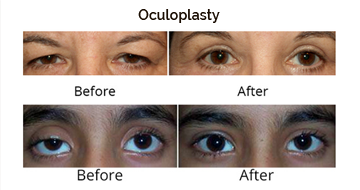
OCULOPLASTY
You have drooping of eyelids which is also known as Ptosis. It can be unilateral or bilateral.
Drooping of the eyelid is called ptosis. Ptosis may result from damage to the nerve that controls the muscles of the eyelid, problems with the muscle strength (as in myasthenia gravis), or from swelling of the lid.
Medical treatment is not always required for ptosis. In some situations, ptosis can go away on its own. Treatment is usually reserved for people with severe drooping that affects their vision. Some people may elect to seek treatment for appearance purposes.
Usually surgery is needed to elevate the droopy eyelids in most people. Your eye doctor may recommend surgery if a droopy eyelid is significantly affecting your ability to see, or if your vision is not compromised but you want your eyelids corrected for cosmetic purpose.
Congenital ptosis will not get better without surgery. However, early correction will help the child to develop normal vision in both eyes. Some acquired ptosis that is caused by nerve problems will improve without treatment.
Sometimes ptosis is an isolated problem that changes a person's appearance without affecting vision or health. In other cases, however, it can be a warning sign that a more serious condition is affecting the muscles, nerves, brain or eye socket.
Drooping eyelids. Drooping of the upper eyelids is the most common symptom recognized in ptosis. ...
Crossed eyes. ...
Double vision. ...
Tilting head back in order to see. ...
Eye and forehead fatigue. ...
Difficulty closing the eye or blinking. ...
Dry or watery eyes.
Yes. Stress-related ptosis presents drooping in the upper eyelid and the eyebrow, and is accompanied by weakness and exhaustion.
Ptosis is more common in older adults. It happens when the levator muscle, which holds up your eyelid, stretches or detaches from the eyelid, causing it to droop. It causes the appearance of asymmetrical eyes, so one eye looks lower than the other.
There is usually very little pain with this procedure. Local anaesthesia is given during the surgery. You will be given an antibiotic ointment which should be applied to the incision site three times a day for one week.
It is called Chalazion. It is a red bump in the eyelid caused by blockage of the meibomian gland in the eyelid. At first, the chalazion may be painful, but after a little time, it usually doesn't hurt.
You should consult your Ophthalmologist to get rid of the swelling. If left untreated may give rise to complications.
The meibomian glands in your upper and lower eyelids make oil that mixes with your tears to moisten and protect your eyes. If the oil gets too thick or if the glands are blocked because of inflammation, you may get a chalazion. Rarely, an infection can cause a chalazion.
A chalazion is not a tumor or growth and does not cause permanent changes in the vision. A chalazion is very common and usually goes away without the necessity of surgery.
Symptoms of skin cancers that develop on the eyelid include: A bump that is smooth, shiny, pearly or waxy, or firm and red. A sore or lump that bleeds or develops a crust or a scab. A flat, flesh-colored or brown scar-like lesion.
Skin that has been burned, sunburned, or injured from disease is at higher risk for eyelid cancer. Squamous cell and basal cell cancers more often occur with repeated, long-term exposure to the sun. Melanoma more often occurs with short-term intense exposure to sun
While the prognosis for eyelid tumors is generally quite good, they must be evaluated and treated promptly. If left untreated, these lesions can grow, and can infiltrate and erode the eye and its surrounding structures.
If you see a lump on the eyelid, or seeing spots or flashes in front of the eye or loss of vision in the sides, a dark spot on the coloured part of the eye (iris) then you should consult your eye doctor for opinion and treatment.